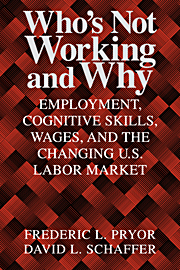Book contents
- Frontmatter
- Contents
- List of tables and charts
- Acknowledgments
- Introduction
- Employment, Cognitive Skills, and Job Displacement
- 2 Cognitive Skills, Education, and Other Determinants of Employment
- 3 Upskilling and Educational Upgrading of Occupations
- 4 Labor Force Displacement Mechanisms
- Wage Levels and Distribution
- Alternative Approaches
- Implications and Interpretations
- Appendix Notes
- Bibliography
- Name Index
- Subject Index
4 - Labor Force Displacement Mechanisms
Published online by Cambridge University Press: 25 March 2010
- Frontmatter
- Contents
- List of tables and charts
- Acknowledgments
- Introduction
- Employment, Cognitive Skills, and Job Displacement
- 2 Cognitive Skills, Education, and Other Determinants of Employment
- 3 Upskilling and Educational Upgrading of Occupations
- 4 Labor Force Displacement Mechanisms
- Wage Levels and Distribution
- Alternative Approaches
- Implications and Interpretations
- Appendix Notes
- Bibliography
- Name Index
- Subject Index
Summary
In Chapter 3 we introduce the concept of “education intensity” and use this idea to group detailed occupations into four broad categories designated as “tiers.” This approach allows us to discuss some important changes in the demand side of the labor market. In particular, we show that over the last quarter-century, jobs requiring relatively little education have increased faster than the number of less-educated prime-age workers while, at the same time, jobs requiring more education have increased more slowly than the number of more-educated prime-age workers.
Given these growing imbalances in supply and demand, labor markets must somehow adjust. Some wage adjustment has occurred, but not all of it is in the “correct” direction. More specifically, by applying a simple textbook supply and demand model of the labor markets, we would predict wages falling in more-educated jobs and rising in less-educated ones. In fact, as we discuss in detail in Chapters 5 and 6, average wages have fallen in less-educated jobs and have stayed approximately the same in more-educated jobs, while wage variance has increased. This is more consistent with excess labor supply for the less-educated jobs, rather than the excess labor demand we demonstrate in Chapter 3. What is happening?
Our interpretation of the data is that there is strong downward wage stickiness for jobs in education-intensive occupations. This stickiness is perhaps due to efficiency wages. That is, firms are reluctant to lower wages too much, thereby risking increases in turnover and shirking, as well as reduced morale. Such changes would lower average productivity, from the firm's view.
Information
- Type
- Chapter
- Information
- Who's Not Working and WhyEmployment, Cognitive Skills, Wages, and the Changing U.S. Labor Market, pp. 74 - 101Publisher: Cambridge University PressPrint publication year: 1999
